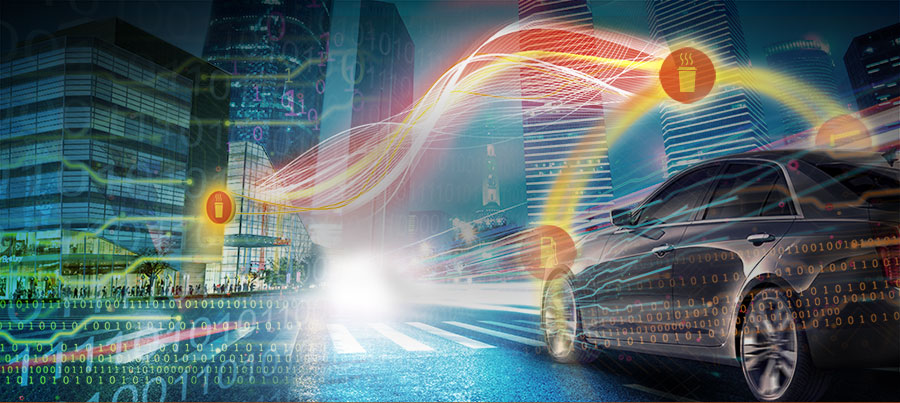The Wall Street Journal: ON Your Smartphone, IN Your Car ~ The Connected Car Race Ensues
Driven by consumer gripes—and by visions of new streams of revenue—auto makers and major players in the smartphone and apps industry dug into their software and hardware to remove a variety of obstacles to smooth integration of vehicle displays and the output from apps.
Apps, the little software programs that make our phones so indispensible, are quickly becoming part of our cars, too.
Now, a wave of new models hitting showrooms have dashboard electronics designed to make it dramatically easier to access smartphone apps that could provide real-time traffic maps, parking access and weather reports on the road. Mercedes-Benz is developing a new infotainment system, based on Apple's CarPlay software, that looks and feels like your iPhone, automotive correspondent Neal Boudette reports.
"This year is a tipping point," said Thilo Koslowski, a Gartner Inc. analyst who follows in-car technology. "There has been a lot of talk about apps in cars, but from 2014 forward, the revolution really happens." BMW AG is working on setting up an app store, modeled on Apple Inc. 's iTunes, to deliver automotive apps to its owners. The store is expected to launch in Europe later this year and in the U.S. in 2015.
For the car makers, electronics and communications capabilities are becoming key selling features, and for many buyers, especially the coveted younger consumers and first-time car buyers, they're more important than horsepower or handling.
"This is a big transition in the industry in the digital context" said Mathias Haller, chief architect of infotainment systems at Audi. Car makers can't afford to fall behind or take a wrong turn on dashboard technology. Ford Motor was an early leader with its Sync system, but later, more complex versions have proved buggy and frustrating to customers, and have hurt the company's standing in quality surveys.
Call it Carapps 2.0. For the past few years, new cars have had the technology—USB ports, microphones, Bluetooth—enabling drivers to make hands-free phone calls. And in some models it is possible to listen to podcasts or stream music from a smartphone. But the first generation of these interfaces were often clunky, distracting and potentially dangerous. Frustrated by confusing voice commands, drivers were forced to pick up their phones—and hope their thumb taps the right icon or swipes the screen the right way to select a song, look up an address, or enter a destination.That won't be the case soon.
Last month at the New York International Auto Show, Mercedes-Benz demonstrated a car equipped with an early version of an infotainment system that uses Apple's iOS extension for automobiles, CarPlay. It has the same look and feel as an iPhone—the icons that appear on the car's display are the same as the iPhone's icons. "If the driver has less to learn, then it makes it more safe," said Kal Mos, Mercedes's director of connected infotainment. Mr. Mos said the system could start appearing in Mercedes vehicles by year end.
The mobile technology providers and car makers remain wary of each other, but they also have a lot to gain if they can win over more consumer.
"It is an absolute arms race to put [smartphone technology] into every car," said Kanwalinder Singh, vice president of business development at Qualcomm Inc., whose computer chips are key components of smartphones and increasingly are turning up in automobiles. About 100 million cars sold each year world-wide, and right now only about 10% have some kind of built-in communications system, he says.
More AutoMotion Insights
Safety experts are hoping new dashboard electronics that work more easily with smartphones eventually will lessen driver distraction. Adrian Lund, president of the Insurance Institute for Highway Safety, said early studies suggest that the distraction problem at least isn't getting worse. While there are more things drivers can do with smartphones, it is becoming easier for them to do these things without taking their eyes off the road and hands off the wheel. "It looks like drivers are no more distracted by all this technology than they were before," Mr. Lund said. Apps for streaming music and navigation are only the start of what people will soon be able to do in their cars. Ford has shown its infotainment system running an app that places orders at the nearest Domino's Pizza outlet. Recently, auto makers have started allowing software developers to draw data from the car itself, like fuel economy. Developers imagine creating apps that track detailed gas mileage for every trip a car makes, or even lets groups of friends or family members view each other's results to see who drives most efficiently.
"Everything that has been showing up in smartphones is going to show up in cars," said Bryan Trussel, founder of Glympse, which makes an app that lets people track the location of friends they are meeting. BMW and other auto makers started embedding Glympse into new cars this year.
Author Neal E. Boudette
© 2025 Created by DealerELITE.
Powered by
![]()


You need to be a member of DealerELITE.net to add comments!
Join DealerELITE.net